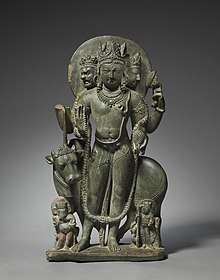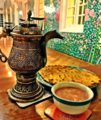
The culture of Kashmir encompasses the spoken language, written literature, cuisine, architecture, traditions, and history of the Kashmiri people native to the northern part of the Indian subcontinent. The culture of Kashmir was influenced by the Persian as well as Central Asian cultures after the Islamic rule of Kashmir. Kashmiri culture is influenced by Hinduism, Buddhism and later by Islam.[1]
Early history
[edit]
Vedic art and culture grew in Kashmir, and some early Vedic hymns were composed there.[2]
The Bharata Natya Shastra, which is notable as an ancient encyclopedic treatise on the arts which has influenced dance, music and literary traditions in Indian culture, originated in Kashmir.[3]
2nd century BC writer Patanjali compiled his compendium on Yoga in Kashmir.[2]
The Panchatantra is also said to have originated in this region.[4]
At the time when Pali was the primary language for Buddhist literature in the rest of India, all the Buddhist literature produced in Kashmir was in Sanskrit. Kashmiri women held high status in society, as Bilhana records that Kashmiri women were fluent both in Sanskrit and Pali.[citation needed]
Kosh Shastra, a work on the science of sex, second to the Kamasutra, was developed in Kashmir.[5]
Some more examples of the major texts that also originated in Kashmir are the Vigyan Bharaiv Tantra, Yoga Sutras, Sapndi Karkika[6] Tantra Loka[7] and Para-Trisika-Vivarana.[8]
Cuisine
[edit]Rice is the staple food of Kashmiris and has been so since ancient times.[9] Meat, along with rice, is the most popular food item in Kashmir.[10] Kashmiris consume meat voraciously.[11] Despite being Brahmins, most Kashmiri Hindus are meat eaters.[12] Kashmiri beverages include Noon Chai or Sheer Chai and Kahwah or Kehew.

The Kashmir Valley is noted for its bakery tradition. Bakers sell various kinds of breads with golden brown crusts topped with sesame and poppy seeds. Tsot and tsochvor are small round breads topped with poppy and sesame seeds, which are crisp and flaky; sheermal, baqerkhayn (puff pastry), lavas (unleavened bread) and kulcha are also popular. Girdas and lavas are served with butter. Kashmiri Bakarkhani has a special place in Kashmiri cuisine. It is similar to a round naan in appearance, but crisp and layered, and sprinkled with sesame seeds.[13] It is typically consumed hot during breakfast.[14]
-
Kashmiri Samovar and Noon Chai
-
Rogan Josh
Festivals
[edit]Kashmiri Hindus
[edit]Primary festivals of Kashmiri Hindus include:
- Herath (Shivaratri)
- Khetchmaavas
- Zyeth Atham
- Tiky Tsoram
- Pann
- Gaad Batt
Kashmiri Muslims
[edit]Primary festivals of Kashmiri Muslims include:
Language and literature
[edit]Kashmiri or Koshur (کٲشُر, कॉशुर, 𑆑𑆳𑆯𑆶𑆫𑇀)[15] is a language from the Dardic subgroup of Indo-Aryan languages, spoken by around 7 million Kashmiris, primarily in the Indian administered territory of Jammu and Kashmir. There are also speakers in parts of the neighbouring Pakistani territory of Azad Kashmir.
The official languages of Jammu and Kashmir are Koshur, Dogri, Hindi-Urdu and English. Kashmiri is recognised as a regional language in the state and is also among the 22 scheduled languages of India.
Kashmiri has split ergativity and the unusual verb-second word order.
Although Kashmiri was traditionally written in the Sharda script,[16][17][18] it is not in common use today, except for religious ceremonies of the Kashmiri Pandits.[19]
Today it is written in Perso-Arabic and Devanagari scripts (with some modifications).[20]
The Perso-Arabic script is recognised as the official script of Kashmiri language by the Jammu and Kashmir government and the Jammu and Kashmir Academy of Art, Culture and Languages.[21][22][23][24]
Nowadays, the Perso-Arabic script has come to be associated with Kashmiri Muslims, while the Devanagari script has come to be associated with the Kashmiri Hindu community.[25]
Music
[edit]
Early history
[edit]The Bharata Natya Shastra is notable as an ancient encyclopedic treatise on the arts one which has influenced dance, music and literary traditions in India, originated in Kashmir.
Present day
[edit]Kashmiri Music primarily includes:
- Chakri
- Henzae
- Rouf or Wanwun
- Ladishah
- Sufiana Kalam (Kashmiri Classical)
References
[edit]- ^ KAW, Mushtaq A. (2010). "Central Asian Contribution to Tradition of Religion-Cultural Pluralism". Central Asiatic Journal. 54 (2): 237–255. JSTOR 41928559.
- ^ a b Nations, United. "Rigvedasamhita, Rigvedasamhita-Padapatha and Rigvedasamhitabhashya" (PDF). Archived (PDF) from the original on 2020-11-13. Retrieved 2020-12-11.
- ^ Kak, S. (2003). "The Wonder That Was Kashmir" (PDF). Louisiana State University. S2CID 9684780. Archived (PDF) from the original on 2021-10-20. Retrieved 2021-10-20.[unreliable source?]
- ^ Datta, Amaresh (1988). Encyclopaedia of Indian Literature: Devraj to Jyoti. Sahitya Akademi. ISBN 978-81-260-1194-0. Archived from the original on 2021-04-19. Retrieved 2020-11-10.
- ^ Tikoo, Colonel Tej K. Kashmir: Its Aborigines and Their Exodus. Lancer Publishers LLC. ISBN 978-1-935501-58-9. Archived from the original on 2021-04-19. Retrieved 2020-11-10.
- ^ Vasugupta; Singh, Jaideva (1992-01-01). The Yoga of Vibration and Divine Pulsation: A Translation of the Spanda Karika with Ksemaraja's Commentary, the Spanda Nirnaya. SUNY Press. ISBN 978-0-7914-1179-7. Archived from the original on 2021-04-19. Retrieved 2020-11-10.
- ^ Toshakhānī, Śaśiśekhara (2010). Rites and Rituals of Kashmiri Brahmins. Pentagon Press. ISBN 978-81-8274-475-2. Archived from the original on 2021-04-19. Retrieved 2020-11-10.
- ^ Vivekananda, Swami (2007). Prabuddha Bharata: Or Awakened India. Swami Smaranananda. p. 354. Archived from the original on 2021-04-19. Retrieved 2020-09-14.
- ^ Bamzai, Prithivi Nath Kaul (1994). Culture and Political History of Kashmir. M.D. Publications Pvt. Ltd. p. 243. ISBN 978-81-85880-31-0. Archived from the original on 2022-02-13. Retrieved 2020-11-10.
Rice was, as now, the staple foodris in ancient times.
- ^ Kaw, M.K. (2004). Kashmir and Its People: Studies in the Evolution of Kashmiri Society. APH Publishing. p. 98. ISBN 978-81-7648-537-1. Archived from the original on 2022-02-13. Retrieved 2020-11-10.
But perhaps the most popular items of the Kashmiri cuisine were meat and rice.
- ^ Press, Epilogue. Epilogue, Vol 3, issue 9. Epilogue -Jammu Kashmir. Archived from the original on 2022-04-07. Retrieved 2020-11-10.
Since Kashmiris consume meat voraciously and statistics reveals that on an average 3.5 million sheep and goat are slaughtered annually for our consumption, the skin can be utilised for production.
- ^ Dar, P Krishna (2000). Kashmiri Cooking. Penguin UK. ISBN 978-93-5118-169-9. Archived from the original on 2022-05-11. Retrieved 2020-11-10.
Though Brahmins, Kashmiri Pandits have generally been great meat eaters.
- ^ "Culture of Anantnag". District Anantnag J&K. Archived from the original on 2009-06-19.
- ^ "Kashmir has special confectionary". Thaindian.com. 2008-03-13. Archived from the original on 2018-05-12. Retrieved 2013-07-18.
- ^ Kashmiri at Ethnologue (25th ed., 2022)

- ^ "ScriptSource - Sharada, Śāradā". www.scriptsource.org. Archived from the original on 2020-03-03. Retrieved 2020-07-14.
- ^ Language: Sharda Script, India, 17 January 2011, archived from the original on 2020-07-03, retrieved 2020-07-01
- ^ Kaul Deambi, B. K. "The Sharada Script: Origin and Development". Kashmiri Overseas Association. Archived from the original on 7 January 2010. Retrieved 18 July 2020.
- ^ Kaul, Omkar Nath. "On Kashmiri Language". Kashmiri Overseas Association. Archived from the original on 25 January 2012. Retrieved 18 July 2020.
- ^ "Kashmiri Language". omnigot. Archived from the original on 14 August 2020. Retrieved 18 July 2020.
- ^ Kaw, M.K (2004). Kashmir and It's [sic] People: Studies in the Evolution of Kashmiri Society. A.P.H. Publishing Corporation. pp. 303–304. ISBN 978-81-7648-537-1. Archived from the original on 2021-04-15. Retrieved 2020-09-14.
- ^ Mahapatra, B.P (1989). The Written Languages of the World: A Survey of the Degree and Modes of Use: India: Book 1 Constitutional Languages. Presses Université Laval. p. 270. ISBN 978-2-7637-7186-1. Archived from the original on 2020-08-05. Retrieved 2020-09-14.
- ^ B. Kachru, Braj. "An introduction to Spoken Kashmiri". Archived from the original on 29 January 2020. Retrieved 18 July 2020.
- ^ Kaul, Omkar Nath. "Spoken Kashmiri A Language Course". Archived from the original on 29 November 2016. Retrieved 18 July 2020.
- ^ "Valley divide impacts Kashmiri, Pandit youth switch to Devnagari - Indian Express". Archived from the original on 2020-10-01. Retrieved 2020-07-01.
External links
[edit]![]() Media related to Culture of Kashmir at Wikimedia Commons
Media related to Culture of Kashmir at Wikimedia Commons






